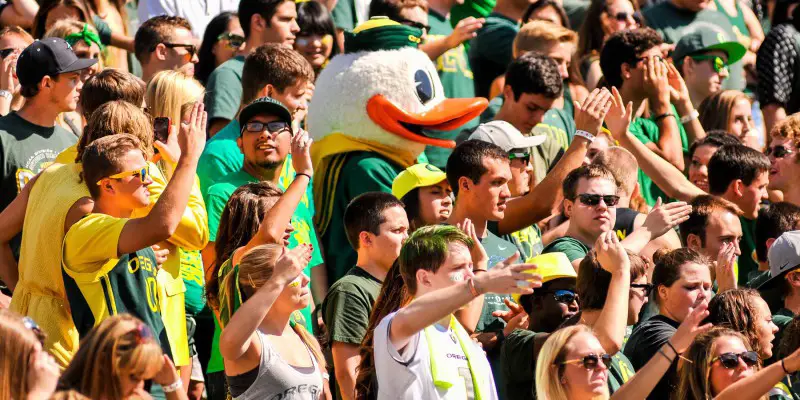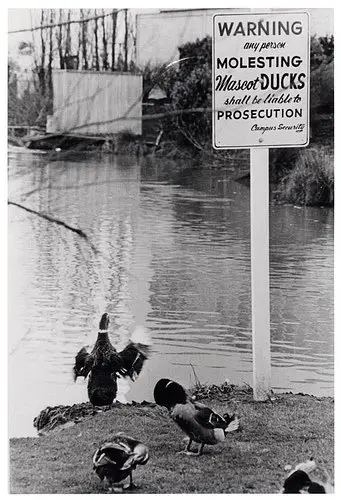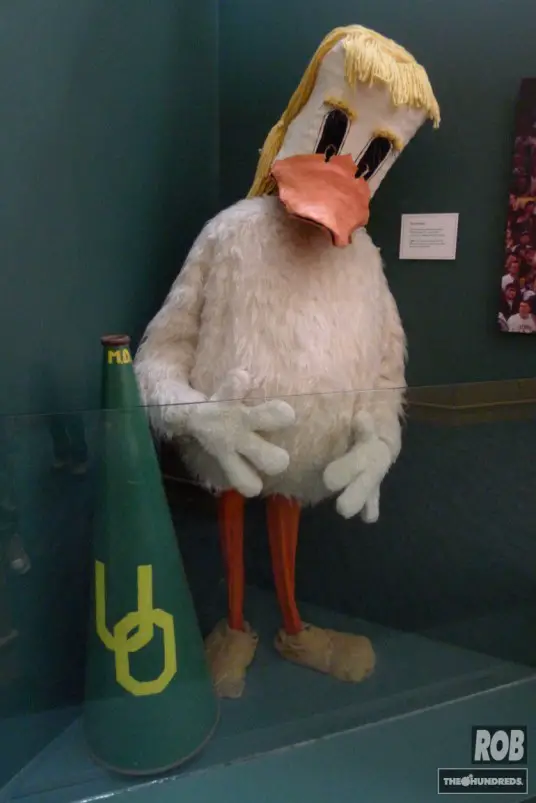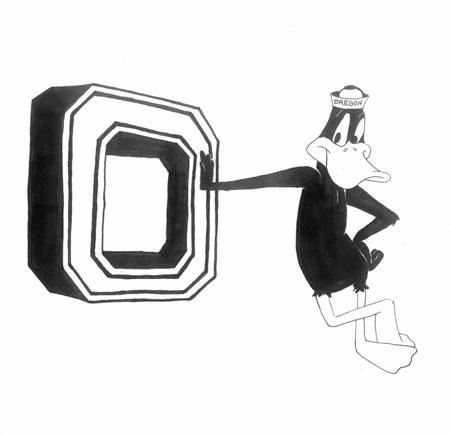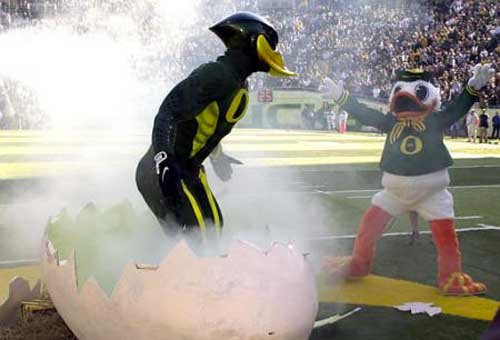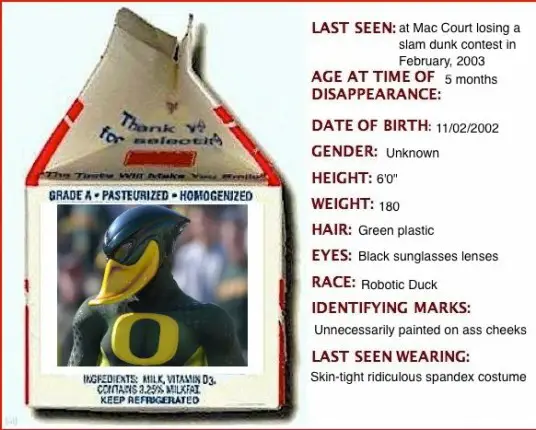 You can call him Donald, The Duck, Ducky, Puddles, or even Duck Diggler…just don’t imitate his trademark post-score pushup celebration or call him a Husky, them’s fightin’ words! Whichever name you prefer, what can never be questioned is that there is not another mascot across the country more beloved than the Purveyor of Pushups, the Deacon of Dance himself, The Oregon Duck.
You can call him Donald, The Duck, Ducky, Puddles, or even Duck Diggler…just don’t imitate his trademark post-score pushup celebration or call him a Husky, them’s fightin’ words! Whichever name you prefer, what can never be questioned is that there is not another mascot across the country more beloved than the Purveyor of Pushups, the Deacon of Dance himself, The Oregon Duck.
Whether it’s appearing in national mascot competitions, playing drums, knocking out several hundred pushups without breaking a sweat, upstaging opposing cheerleaders in impromptu dance competitions, or distracting TV personalities while they are trying to broadcast; The Duck has elevated himself above all others as the premier mascot in the country. Not much for words but never short on action, the Duck loves his fans, and his fans young and old love him. Donning costumes as varied as a gladiator, a Trojan horse, a giftbox, Darkwing Duck, a B-boy, and even Lee Corso; this multi-talented duck is the epitome of cool.
But The Duck has not been without its challenges nor challengers, resilient enough to withstand multiple attempts to replace or outright erase his lovable mug, it has been the passion exuded for the Duck from students and fans that has ensured that The Duck would remain forever tied to the University of Oregon.
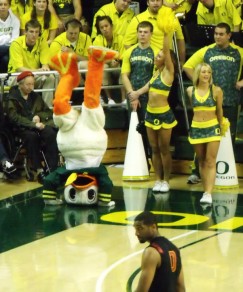 Now technically old enough to collect social security (though perhaps duck years are calculated different than human years?), The Duck is as spry and hip as ever. Before The Duck first appeared on the sidelines of a football game in 1947, his descendants were live ducks, rescued from the Mill Race by Oregon students, nursed back to health, and paraded out on the sidelines during games. However, to find out The Duck’s true roots, it necessitates going all the way back to the American Revolutionary War.
Now technically old enough to collect social security (though perhaps duck years are calculated different than human years?), The Duck is as spry and hip as ever. Before The Duck first appeared on the sidelines of a football game in 1947, his descendants were live ducks, rescued from the Mill Race by Oregon students, nursed back to health, and paraded out on the sidelines during games. However, to find out The Duck’s true roots, it necessitates going all the way back to the American Revolutionary War.
THE DUCK’S ROOTS
In December 1776 the Continental Army was floundering against the might of the British forces, but the Battle of Trenton gave General Washington a much needed victory that reinvigorated enlistment and further spurred the revolution. The key to the battle was a dangerous night crossing of the Delaware River by Washington’s army to surprise the Hessian forces occupying Trenton, NJ at dawn, the traverse immortalized in a painting years later. The men at the helm of the boats were a group of fishermen from Marblehead, Mass., known as “The Webfoot Regiment.”
Some of the descendants of the veterans of the famed Massachusetts Webfoot Regiment would be among the first to settle the area west of the Cascades comprising Oregon’s Willamette Valley, lending the initial nickname for the state of Oregon as “The Webfoot State.” It seemed only natural then that when the University of Oregon was founded in 1876 it would carry the moniker of Oregon residents, becoming the University of Oregon Webfoots. It would not be until 1909 that Oregon became known as “The Beaver State.”
When students began bringing a live duck, nicknamed “Puddles,” to games starting in 1920 (followed by subsequent Ducks also known as Puddles), it seemed only natural that journalists would apply ‘Ducks’ to their headlines as a simpler nickname than ‘Webfoots.’
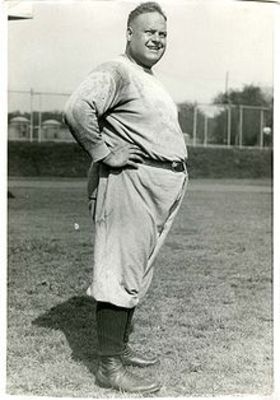
Oregon almost became known as The Spearsmen, named after Coach C.W. Spears, who promptly left the school for another job
In 1926 a naming contest made the Webfoots name official, crediting L.H. Gregory, editor of The Oregonian, with the name. It was selected over names like The Skinners (for Eugene Skinner, founder of Eugene), The Gorillas, or The Dragons. Six years later a student-led vote affirmed the Webfoots nickname, selected over alternates like The Pioneers, Wolves, Lumberjacks, Trappers, Yellow Jackets, and Spearsmen.
It was probably a good thing that students turned down the Spearsmen nickname, in reference to football coach C.W. Spears, as shortly after the vote he promptly left Oregon for a coaching job at Wisconsin before the start of the football season. Yet while the school officially was known as the Webfoots, common lexicon and the newspapers often referred to the teams as the shorter “Ducks” name.
Meanwhile the Walt Disney Company in California was finding great success with their early animated cartoon character Mickey Mouse and other films, and in 1934 expanded their repertoire with a new character, a feisty anthropomorphic White Duck in a sailor suit named Donald Duck.
Donald Duck first appeared in the 1934 Disney cartoon “The Wise Little Hen.” Donald Duck has since appeared in more Disney animations than any other character.
The brash attitude and quick temper of Donald perfectly personified the Fighting Webfoots mentality desired by Oregon fans, it was kismet that as Donald Duck’s popularity rose comparisons would be made to the Oregon Webfoots/Ducks. By 1940 Oregon students were creating cartoons in the school paper depicting the Puddles mascot as Donald Duck, much to the chagrin of Disney.
While live mascots are a long tradition at certain colleges, members of the Humane Society in Oregon had strong objections to the ongoing practice of students capturing live ducks, despite the instant popularity of Puddles at events. Eventually by 1947 the public quacking over entrapping a live “Puddles” duck became enough of an issue that Athletic Director Leo Harris felt a change was needed.
(Note: many schools have addressed the issue of keeping a live mascot by simultaneously also having a costumed mascot. Georgia, LSU, Texas, and Colorado are just a few of the schools that continue to utilize both)
As luck would have it Harris was friends with an animator that worked for Walt Disney, and with the Disney company’s lawyers already huffing about the unlicensed likeness of Donald Duck appearing in print, Harris provided an alternative. Rather than shutting down the Donald Duck likeness, why not make Donald the official mascot? After being passed along to Walt Disney himself, Walt’s blessing was given to make Donald an Oregon Duck. To the relief of the Humane Society, Puddles’ descendants were released from captivity, and The Duck was born.
THE DUCK’S EARLY DAYS
For his first appearance on September 20th, 1947, a 27-14 victory over Montana State at Hayward Field, The Duck more resembled a duckling rather than the fit Donald-esque Duck we know today.
For nearly 20 years the Disney company and the University of Oregon had a unique agreement in place, the only school in the country permitted to have a mascot modeled after a trademarked character owned by an outside corporation. The Disney company provided several variations of an Oregon-specific Donald over the years for use in print, but after Walt Disney’s death in 1966 a problem emerged…lawyers at Disney realized that they could find no evidence of any formal contract between the University of Oregon and Disney to use the Donald Duck likeness.
For several years The Duck’s status remained in legal limbo, the threat of becoming extinct with the stroke of a pen if no evidence of a Disney-Oregon agreement could be found. An exhaustive search of the archives unveiled only one key piece of evidence, a photo of Leo Harris with the last “Puddles” in 1947 alongside Walt Disney, wearing matching lettermen jackets with a Donald Duck Oregon logo embroidered on the chest.
It was good enough.
By 1973, a contract was in place that permitted the university to continue using Donald Duck’s likeness as a mascot, while Disney retained control of his appearance in print and marketing outside of the state of Oregon. The school had to gain approval from Disney for the mascot to perform at events beyond athletics, and demanded that the student inside the costume represent the Donald Duck-like character in a proper manner (this was put to the test in 2007 when an on-field incident with the Houston Cougar resulted in The Duck being suspended for the following game, though he did make a brief appearance in the TV booth apologizing for his behavior). The agreement stated that the university was “granted the right to use Donald’s likeness as a symbol for (and restricted to) Oregon sports.”
With the lawyers content, The Duck’s future with the University of Oregon was assured…or was it?
CRITICS EMERGE
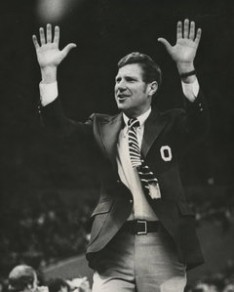
Coach Harter disliked the ‘Ducks’ nickname so much he demanded all mentions of his team appear as “The Kamikaze Kids”
Not everyone was happy with the duck name or appearance. Football coach Jerry Frei (1967-1971) thought that the Donald Duck likeness wasn’t vicious enough to match the “Fightin’ Ducks” spirit in spite of Donald’s ill-tempered reputation, and lobbied to have sharp teeth added to show a meaner demeanor. Thankfully, in spite of Frei’s efforts, the Duck was able to remain fang-free.
Frei wasn’t the only coach at Oregon with disdain for the Duck; basketball coach Dick Harter (1971-78) didn’t want to have anything to do with the lovable water fowl, demanding that any reference made to his team should be as “The Kamikaze Kids” rather than ducks. During this time the nickname “Webfoots” was still in use somewhat, but slowly being phased out in favor of the more popular Ducks.
The attempts to end The Duck’s reign as king of campus returned a few years later, as an effort was made to end the Disney restrictions by creating an all-new Duck, albeit a misguided attempt in copyright by replacing one popular likeness with another. Steve Sandstrom, a cartoonist with the Oregon Daily Emerald, suggested that instead of The Duck being based on Disney’s popular all-white Donald Duck, why not instead change the mascot to the all-black look of the Warner Brothers’ popular cartoon character Daffy Duck, or “Mallard Drake” as he would be known around campus.
The Donald vs. Daffy debate became heated enough that once more it was put up for a vote to determine who the students wanted to represent the school. By a nearly 2-to-1 margin, Donald was selected to remain, the people’s champion once more.
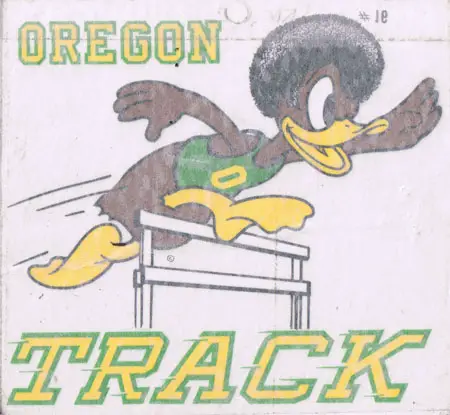 While The Duck remained modeled after Donald Duck, there have been numerous changes to the appearance over the years. The Oregon logo itself has changed several times, and for a time in the early 70s The Duck appeared often depicted as all-brown and sporting an Afro haircut.
While The Duck remained modeled after Donald Duck, there have been numerous changes to the appearance over the years. The Oregon logo itself has changed several times, and for a time in the early 70s The Duck appeared often depicted as all-brown and sporting an Afro haircut.
EMBRACING THE FAMILY
Despite the critics, it was clear that The Duck was in Oregon to stay. So for the 50th anniversary of Donald Duck’s first appearance for Disney in 1984, a special ceremony was held in Eugene. Donald was flown up from Disneyland to the Eugene Airport, where several thousand fans welcomed him to his home away from home, a duck actually flying north for the winter. Donald was presented with a cap and gown and declared an honorary alumnus of the University of Oregon, and given a large scroll autographed by Eugene residents.
A decade later Disney was able to return the favor, rolling out the red carpet for The Duck’s trip to Disneyland prior to the 1995 Rose Bowl. It was the first time that any non-Disney mascot had ever appeared at Disneyland, birds of the same feather flocking together as Donald Duck welcomed The Oregon Duck to his stomping grounds.
While Donald Duck may now be considered a college graduate, The Oregon Duck remains a fixture on campus, attending the University of Oregon for 65 years now and counting. The two subsequent trips Oregon has made to the Rose Bowl in 2010 and 2012 were again treated like family reunions by the two Duck mascots, one big happy Duck family.
FREE FROM DISNEY
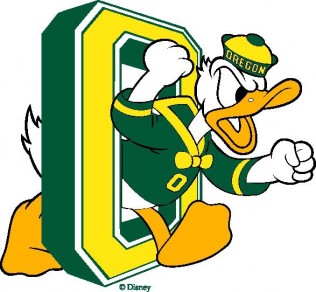 The early 2000s was an amazing time at the University of Oregon. The athletic program in multiple sports was having unprecedented success, and all of campus was experiencing a facelift thanks in large part to a close relationship with Nike, which had been founded on the University of Oregon campus decades earlier.
The early 2000s was an amazing time at the University of Oregon. The athletic program in multiple sports was having unprecedented success, and all of campus was experiencing a facelift thanks in large part to a close relationship with Nike, which had been founded on the University of Oregon campus decades earlier.
A new logo had appeared following the 1998 season. The Angry Donald logo that had been a fixture of Oregon athletics had been replaced with a new Nike design, the O, a silhouette of Hayward Field overlapping Autzen Stadium.
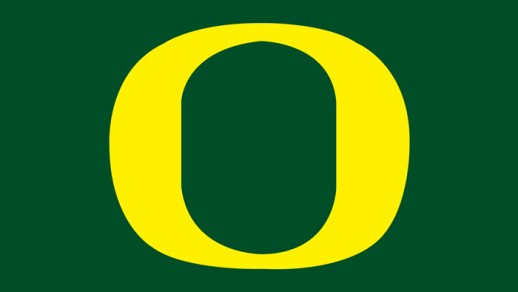 The O logo was just one part of the vast marketing efforts to update the University of Oregon, and the modernization too set its sights upon The Duck. Looking to present a mascot that would be free of the burden of Disney regulations, Oregon unveiled a new mascot with the assistance of Nike.
The O logo was just one part of the vast marketing efforts to update the University of Oregon, and the modernization too set its sights upon The Duck. Looking to present a mascot that would be free of the burden of Disney regulations, Oregon unveiled a new mascot with the assistance of Nike.
First emerging from a giant egg at Autzen Stadium during the 2002 USC-Oregon game, Roboduck wasn’t seen as a full-time replacement for The Duck, but a meaner, more agile Duck that could become part of Oregon’s nationwide branding efforts free of Disney’s oversight. Fitter, more athletic, with a 21st century zest, Roboduck proved to be a dismal failure…
Booed from the start, nobody could quite give a specific reason as to why Roboduck was so universally hated, he just was. Perhaps it was as simple as the fact that Roboduck was not The Duck, by now such a beloved character in the minds of Oregon fans that he could probably win a state senate or gubernatorial election should he ever seek political office.
Fans wanted The Duck, not a futuristic abomination. Every time Roboduck made an appearance, garbage was thrown in its general direction as angry fans threatened violence towards it. By spring of 2003 the message had been received loud and clear, Roboduck had to go.
Following a halftime slamdunk contest between The Duck and Roboduck (one in which fans overwhelmingly cheered to declare The Duck the winner) at a men’s basketball game in early 2003, Roboduck sulked away into the dungeons of McArthur Court, never to be seen or heard from again.
While the University of Oregon was quickly becoming a national powerhouse in athletics and prominently featured by the media, The Duck was still under strict rues from the Disney contract signed in 1973. That would all unintentionally change in 2009, spurred by the actions of several students creating a class project.
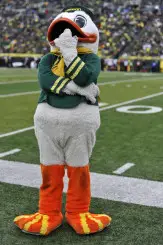
Puddles.
As a class project, a group of students calling themselves Supwitchugirl created a song and accompanying music video professing their passion for The Ducks. The song “I Love My Ducks” featured the mascot in several scenes thanks to the help of a fellow student, but neither the university nor Disney were aware of the fact that the Duck would be appearing in the project. When the video was posted on YouTube and quickly went viral, it caused a potential legal backlash, and the students were forced to pull the video from public viewing…but it was too late, fans simply re-posted it.
Sensing the futility in keeping the video under wraps and weary of seeking approval from Disney for every appearance The Duck makes, both parties instead agreed that it was time to bring Disney’s oversight to an end. Beginning in 2010, no longer would Disney relegate where the mascot could appear, The Duck was finally free to make public appearances wherever he decided to flock to, though Disney would retain trademark of The Duck in graphic art.
Finally, The Duck was free to appear everywhere, and oh did he make his presence felt. The 2010 football season proved to be a huge year for The Duck. In the opening game of the season vs. New Mexico, Oregon’s 72-0 victory led to a total of 506 pushups performed before the crowd (The Duck does one pushup for every point scored cumulative throughout the game) that garnered national attention and interview requests.
A month later again national attention came The Duck’s way, after video footage capturing an impromptu dance competition with a USC cheerleader during a broadcast of ESPN College Gameday received hundreds of thousands of views online.
In the time since it seems like the Duck cannot be avoided, appearing in multiple national television ads, competing in the Capitol One Mascot Challenge, and running amok at various events in Oregon and beyond.
Hundreds of videos online showcase the Duck’s antics, causing him to grow further in popularity. Multiple media personalities have publicly praised The Duck. Lee Corso said The Duck was his favorite mascot, as evidenced by the numerous times he has adorned the head at the end of ESPN College Gameday broadcasts. Michelle Beadle of ESPN called The Duck one of the best dancers she has ever seen. And no mascot can disrupt the concentration of a broadcaster quite like him either.
Whether it be on TV, on the slopes, in the water, roaming around town, conducting an orchestra, or appearing at the surprise of all at random moments, there is no character calling the northwest home more loved than The Duck. From the tiniest toddler to the eldest Duck fan, it seems the Duck is everywhere these days, assured that he will always have a home at the University of Oregon.
This past football season the team even went so far as to honor their biggest fan, by wearing “throwback” Fighting Ducks uniforms that featured The Duck’s head on the shoulder pads. The Duck in turn sported a uniform featuring the silhouette of coach Chip Kelly’s head.
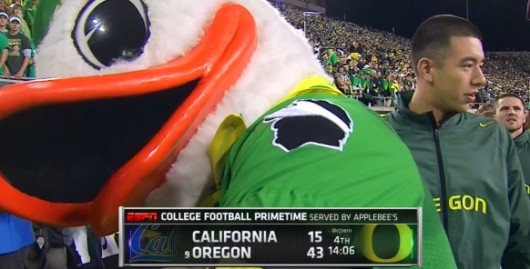 Recently, the Oregon men’s basketball team wore a uniform that incorporated this same design with The Duck.
Recently, the Oregon men’s basketball team wore a uniform that incorporated this same design with The Duck.
On gamedays you can always find The Duck roaming the stands or sidelines, entertaining fans while armed with a plethora of costumes and toys, always making his presence felt. For the first game played at the new Matthew Knight Arena, The Duck “flew” down from the ceiling. At football games, you can find him riding on the back of the Duck Harley-Davidson motorcycle leading the team onto the field.
Sometimes his handy “noise machine” makes an appearance, other times it’s his handy shakeweight or light saber.
But no matter where The Duck may appear and armed with who knows what, the one certainty is that he will always be embraced with open arms and lavished with hugs, waves, shouts, and smiles. While modeled after Donald Duck, the Oregon Duck’s personality is more along the lines of Goofy, always charming, lovable, and quick-witted guaranteed to bring a laugh.
We love our Oregon Duck.
Top Photo by Craig Strobeck
These are articles where the writer left and for some reason did not want his/her name on it any longer or went sideways of our rules–so we assigned it to “staff.” We are grateful to all the writers who contributed to the site through these articles.

